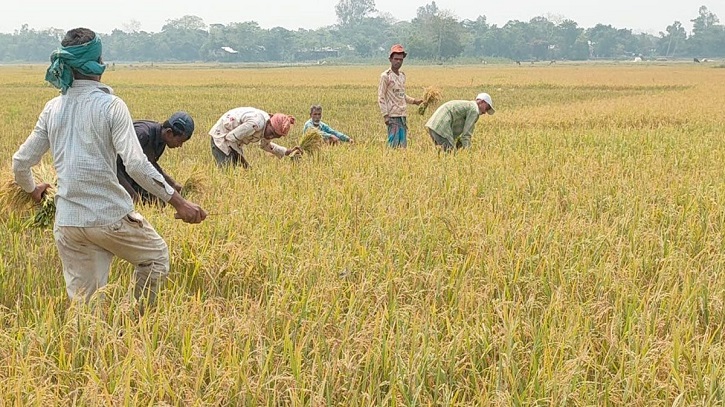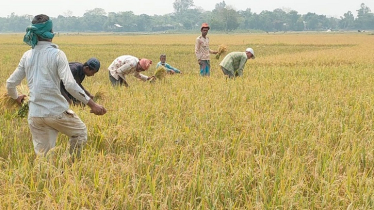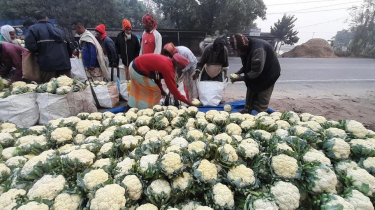
Reports of bumper Aman yields surface almost every year, but this season’s outcome in Chatak upazila of Sunamganj appears exceptionally promising. For many years, marginal farmers struggled to access agricultural technologies due to irregularities, mismanagement, syndicates and bureaucratic complexities. This season, however, the situation has changed significantly. Freed from those long-standing obstacles, Chatak’s Aman growers have benefitted from technology and improved cultivation methods more effectively than ever before, bringing a renewed sense of optimism to the haor-dominated region.
Chatak has once again recorded strong yields in the transplanted Aman season. The positive influence of modern technology, training and improved cultivation techniques has translated into smoother implementation on the ground. Unlike in previous years, no influential intermediaries obstructed access to equipment and support. Authorities appeared to prioritize farmers’ needs above all else, resulting in a visible improvement in livelihoods across the area.
Regular field inspections, quality pesticide supplies and easy access to high-yield seed varieties contributed to increased production. Harvesting is now in full swing across the vast stretches of ripened Aman fields in the remote villages. As winter approaches, the bumper yield is expected to bring a festive atmosphere to most farming households. Officials add that the government is also working to ensure fair prices for paddy and rice so that farmers are adequately compensated for their labor.
According to the local agriculture office, Aman cultivation in the 2025–26 fiscal year covered 12,950 hectares across 13 unions and one municipality within the upazila. The Department of Agricultural Extension estimates production at approximately 51,196 tons. During the 2024–25 season, 13,060 hectares produced 50,430 tons of Aman paddy. Despite slightly reduced acreage this year, total output has increased, reflecting farmers’ improved management and greater access to technological support.
Earlier seasons show a similar pattern: in 2023–24, 13,050 hectares yielded 50,388 tons, while 12,950 hectares produced 49,070 tons in 2022–23. In 2021–22, 13,060 hectares produced 50,430 tons. Although the cultivated land area remains nearly consistent each year, this season’s production surpasses that of the past three to four years.
In recent years, the government has been providing technology-based support to enhance crop production in the region. Although procurement and distribution of harvesters, seed and agricultural machinery previously faced irregularities, this season the process has been transparent. Under various projects, farmers received 51 combine harvesters, 26 reaper machines, 42 crusher machines, 39 sprayer machines, 15 garden tillers and several other modern tools, all dedicated exclusively for agricultural use.
At the beginning of the season, 3,000 farmers received training in 100 batches under multiple development projects. With this preparation completed ahead of planting, farmers were able to begin their fieldwork with full readiness. Authorities have also started taking measures to ensure fair pricing once the newly harvested Aman crop enters the market.
This season, the agriculture office distributed improved seed varieties including BR-22, BRRI-49, BRRI-51, BRRI-52 and BRRI-75, along with nine other modern varieties. Farmers also cultivated traditional local varieties such as Kalijira, Chinigura, Tulsimala, Guti Iri, Begunbichi and Chengarmuri. During a visit to the crop fields of Madhabpur village in Kalaruka Union, farmers were seen working in groups, harvesting paddy with sickles, threshing and winnowing on the spot, while women contributed by drying the grain. Farmer Faruk Ahmed, who planted Aman on 20 bighas, expressed satisfaction and said the yields have been excellent.
Upazila Agriculture Extension Officer Shah Alam stated that before planting began, 750 farmers were supplied with improved seeds free of cost. Each beneficiary received five kilograms of paddy seed per bigha, along with 10 kg DOP and 10 kg MOP fertilizer. Furthermore, 10,000 kg of urea fertilizer and equal quantities of DOP and MOP were distributed for 250 demonstration plots across the upazila. Upazila Agriculture Officer Mohammad Toufique Hossain Khan added that weather conditions remained favorable throughout the season, further contributing to the strong yield.





